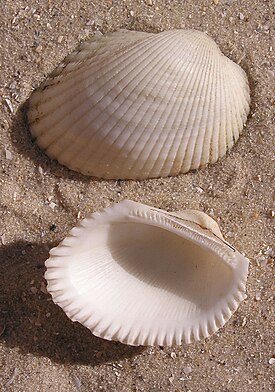Anadara inaequivalvis (Latin) is a type of bivalve mollusks from the arch family (Arcidae).
| Anadara inaequivalvis | |||||||||||||||||||||||||||
 Shell of the mollusk, the dark-colored outer layer of the shell is not preserved | |||||||||||||||||||||||||||
| Scientific classification | |||||||||||||||||||||||||||
|---|---|---|---|---|---|---|---|---|---|---|---|---|---|---|---|---|---|---|---|---|---|---|---|---|---|---|---|
| |||||||||||||||||||||||||||
| International Scientific Name | |||||||||||||||||||||||||||
Anadara inaequivalvis ( Bruguière , 1789) | |||||||||||||||||||||||||||
| Synonyms | |||||||||||||||||||||||||||
| |||||||||||||||||||||||||||
Content
Build
Small clam, shell length - 9.5 cm, usually up to 8 cm.
Spread
The natural range of this species covers the central part of the Indian Ocean from India and Sri Lanka to Indonesia, as well as the western Pacific Ocean to the north to Japan, to the south to northern Australia. As an introduced species, it was noted in the Mediterranean, Adriatic (in the northern part), Black and Azov seas (in the western and southern parts). In the Philippines and in Japan, it is used as an object of mariculture .
In the Black Sea, it was first noted off the coast of Bulgaria in 1983, where it was brought with ballast of ships from the Adriatic Sea [2] . As a result, this mollusk settled along the entire Black Sea coast, completing the colonization of the Black Sea-Azov basin by settlement in the southern and northwestern Azov Sea, where it was recorded in the Kerch Strait, near the town of Kirillovka and on the Fedotova Spit [3] .
Notes
- ↑ View of Anadara inaequivalvis (Bruguière, 1789) (Eng.) In the World Register of Marine Species .
- ↑ Ghisotti F., Rinaldi E. Osservazioni sulla popolazione di Scapharca insediatasi in queti ultimi anni su untratto dellitoraleromagnolo // Conchiglie.- 1976. - 12.9 −10.- R. 183–195.
- ↑ Anistratenko V.V., Khaliman I.A., 2006. Anadara inaequivalvis bivalve mollusk (Bivalvia, Arcidae) in the northern part of the Sea of Azov: the completion of the Azov-Black Sea basin colonization. Bulletin of Zoology, 40 (6): 505-511
Literature
- Volovnik S. V. The new inhabitant of the Sea of Azov - the mollusk of Anadar // [[Melitopol Local History Journal, 2013, №2, p.94-96
- The living marine resources of the Western Central Pacific / KE Carpenter, VH Niem (eds.). - Rome: FAO, 1998. - Vol. 1. Seaweeds, corals, bivalves and gastropods. - P. 152. - (FAO species identification guide for fishery purposes). (inaccessible link)
Links
- GENERAL FISHERIES COMMISSION FOR THE MEDITERRANEAN
- Dumpling Unequammer - AQUACULTURE OF RUSSIA